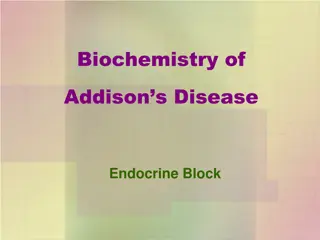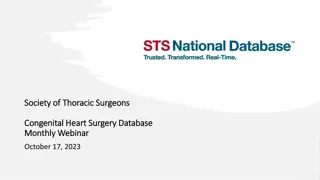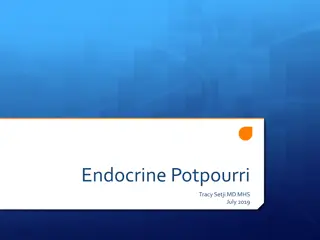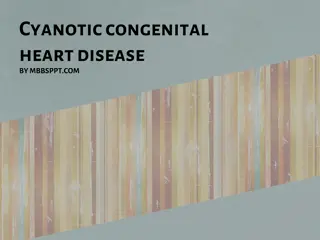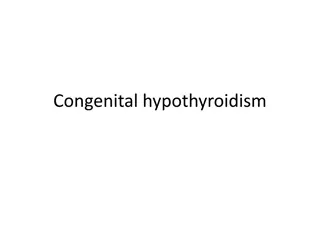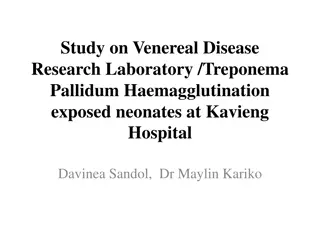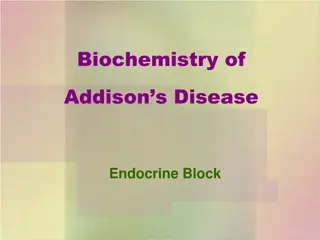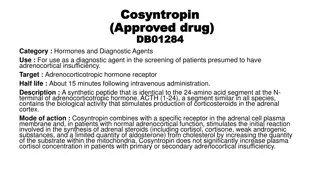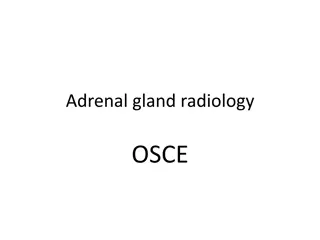
Congenital Adrenal Hyperplasia - Causes, Symptoms, and Treatment
Congenital Adrenal Hyperplasia (CAH) is a group of genetic disorders affecting cortisol biosynthesis, causing varied clinical manifestations. Learn about its different subtypes, such as 21-hydroxylase deficiency, aldosterone synthase deficiency, and lipoid adrenal hyperplasia. Early detection and appropriate management are crucial for individuals with CAH.
Download Presentation

Please find below an Image/Link to download the presentation.
The content on the website is provided AS IS for your information and personal use only. It may not be sold, licensed, or shared on other websites without obtaining consent from the author. If you encounter any issues during the download, it is possible that the publisher has removed the file from their server.
You are allowed to download the files provided on this website for personal or commercial use, subject to the condition that they are used lawfully. All files are the property of their respective owners.
The content on the website is provided AS IS for your information and personal use only. It may not be sold, licensed, or shared on other websites without obtaining consent from the author.
E N D
Presentation Transcript
CONGENITAL ADRENAL HYPERPLASIA Dr Mozhgan Karimifar Assistant Prof. of Endocrinology Isfahan University Of Medical Sciences 2
CONGENITAL ADRENAL HYPERPLASIA CAH comprises a group of autosomal recessive disorders caused by deficient adrenal corticosteroid biosynthesis. It results from defects in one of the steroidogenic enzymes involved in cortisol biosynthesis or in the electron providing factor, POR.
CONGENITAL ADRENAL HYPERPLASIA cortisol production (ACTH) ACTH adrenal hyperplasia and accumulation of cortisol precursors and/or overproduction of ACTH-dependent adrenal steroids along other pathways 4
Clinical manifestations of CAH The clinical manifestations of the different disorders are due to diminished production of cortisol and, depending upon the site of block, decreased or increased production of mineralocorticoids and/or androgens. 5
Congenital lipoid adrenal hyperplasia Caused by StAR deficiency affecting mitochondrial cholesterol uptake, is a subform of this disease complex with the unique feature of lipid accumulation leading to cell destruction. W533 6
Aldosterone synthase deficiency Aldosterone synthase deficiency does not affect glucocorticoid biosynthesis and does not lead to adrenal hyperplasia, but it has been historically grouped into this disease complex. W533 7
21-Hydroxylase Deficiency Between 90% and 95% of cases of CAH are caused by 21-hydroxylase deficiency. In Western societies, the incidence varies from 1 in 10,000 to 1 in 15,000 live births but in isolated communities the incidence may be much higher (e.g., 1 : 300 in Alaskan Inuit populations). Nonclassic CAH is more common, with an incidence of about 1 in 500 to 1 in 1000 live births. W533 11
21-Hydroxylase Deficiency The condition arises because of defective conversion of 17 -OHP to 11-deoxycortisol. cortisol negative feedback drive ACTH , adrenal androgens mineralocorticoid (75%)because of failure to convert sufficient progesterone to DOC in the ZG. W533 12
21-Hydroxylase Deficiency Clinically, several distinct variants of 21-hydroxylase deficiencyhave been recognized W533 14
Simple Virilizing Form ACTH adrenal androgen secretion in utero virilization Affected female fetus Depending on the severity: Clitoral enlargement Labial fusion Development of a urogenital sinus Sexual ambiguity at birth and even inappropriate sex assignment W535 17
Simple Virilizing Form Males are: phenotypically normal at birth and are at risk of not being diagnosed; this explains the skewed female-to-male ratio of simple virilizing CAH diagnosed in the preneonatal screening era. W535 18
Simple Virilizing Form Males patients may present in precocious pseudopuberty pubic hair development Growth acceleration due to premature androgen excess If left untreated, this stimulates premature epiphyseal closure, and final adult height is invariably diminished W535 19
Salt-Wasting form of 21-Hydroxylase Deficiency In addition to the described features, neonates commonly present after the first 2 weeks of life with a salt-wasting crisis and hypotension. W535 20
The clinical signs and symptoms of salt wasting Include : Poor feeding Vomiting Failure to thrive Lethargy Sepsis-like symptoms Delayed diagnosis of male baby (significant neonatal mortality rate) W536 21
Nonclassic or Late-Onset 21-Hydroxylase Deficiency Present in childhood or early adulthood with premature pubarche or with a phenotype that may masquerade as polycystic ovary syndrome (PCOS). More common than the classic variant W536 22
Nonclassic or Late-Onset 21-Hydroxylase Deficiency At least 30% of adult patients have an impaired cortisol response to ACTH(1-24) and may be prone to stress-induced adrenal insufficiency. Routine assessment of adrenal glucocorticoid reserve is indicated. W536 23
Nonclassic or Late-Onset 21-Hydroxylase Deficiency In some series from tertiary referral centers, nonclassic 21- hydroxylase deficiency accounts for up to 12% of all PCOS patients, but more realistic prevalence rates are probably 1% to 3%. W536 24
Nonclassic or Late-Onset 21-Hydroxylase Deficiency Females present with: Hirsutism Primary or secondary amenorrhea Anovulatory infertility Androgenic alopecia Acne W536 25
Mutations in the human 21-hydroxylase gene Salt wasting, simple virilizing, and late-onset 21-hydroxylase deficiency are all caused by homozygous or compound heterozygote mutations in the human 21-hydroxylase gene (CYP21A2). W536 26
Heterozygote 21-Hydroxylase Deficiency In the carrier or heterozygote state, only one allele is mutated. The clinical significance of the heterozygote state is uncertain; it does not appear to disadvantage reproductive capability but may cause signs of hyperandrogenism in adult women. W536 27
Molecular Genetics of CAH 21-Hydroxylase deficiency is inherited as an autosomal recessive trait, and the higher incidence of the condition consanguinity. The CYP21A2 gene and its highly homologous pseudogene (CYP21A1P) are located on the short arm of chromosome 6 (6p21.3). Approximately 65% to 75% of CAH patients are compound heterozygous for the disease-causing mutations. 28
Diagnostic Criteria of 21-hydroxylase Deficiency in any newborn infant with genital ambiguity and salt wasting, hypotension, or hypoglycemia Hyponatremia and hyperkalemiawith raised plasma renin activity are found in salt-wasters. In later life, adrenal androgen excess (DHEAS, androstenedione) is found in patients presenting with sexual precocity or a PCOS-like phenotype. w536 29
Diagnostic Criteria Classic 21-hydroxylase deficiency 17-OHP (randomly timed ) 17-OHP (salt-wasting CAH )>non salt-losing w536 30
Stimulation tests 17-OHP is measured basally and then 60 minutes after administration of 250 g Synacthen. Stimulated values are invariably grossly elevated (>35 nmol/L [>11 g/L = ng/ml ]) in patients with classic and nonclassic forms of the disorder. There is some overlap between values seen in heterozygotes and in normal subjects. 31
Diagnostic Criteria Heterozygote patients usually have stimulated values between 10 and 30 nmol/L (330 and 1000 ng/dL). w536 32
Diagnostic Criteria Basal 17-OHP <5 nmol/L (<150 ng/dL) in the follicular phase of the menstrual cycle effectively excludes late-onset 21-hydroxylase deficiency w536 33
When do you suggest genotyping in individuals with CAH? Results of the adrenocortical profile after a cosyntropin stimulation test are equivocal Cosyntropin stimulation cannot be accurately performed (i.e., patient receiving GC) Purposes of genetic counseling Technical remark: Genotyping at least one parent aids in the interpretation of genetic test results because of the complexity of the CYP21A2 locus.* Congenital Adrenal Hyperplasia Due to Steroid 21-Hydroxylase Deficiency: An Endocrine Society* Clinical Practice Guideline J Clin Endocrinol Metab, November 2018, 103(11):1 46 35
Prenatal Diagnosis of 21-Hydroxylase D has been advocated, because treatment of an affected female may prevent masculinization in utero 17-OHP can be assayed in amniotic fluid, but the most robust approach is the rapid genotyping of fetal cells obtained by chorionic villous sampling in early gestation. w538 36
when a fetus is known to be at risk? An affected sibling Both partners are known to be heterozygous for one of the severe mutations uptodate 37
Prenatal Diagnosis of 21-Hydroxylase D In patients with known 21-hydroxylase deficiency (male or female) seeking fertility, determination of 17-OHP levels across an SST in the partner before conception will uncover nonclassic or heterozygote cases and provide the endocrinologist/geneticist with some assignment of risk before pregnancy. W538 38
Prenatal diagnosis of 21-hydroxylase deficiency provide parents with information prenatal therapy is contemplated However, because adverse effects of prenatal therapy (on the fetus and mother) have been described and long-term risks are unknown, the decision to treat should only be considered in consultation with a highly experienced team in a research setting and after a detailed discussion with the pregnant couple. uptodate 39
Chance of having CAH The fetus will have a 1:4 chance of having CAH and a 1:2 chance of being female; thus, there is a 1:8 chance that the fetus will be female and have CAH. Because the period during which fetal genitalia may become virilized begins ;6 weeks after conception, treatment must be started by 6 to 7 weeks. Congenital Adrenal Hyperplasia Due to Steroid 21-Hydroxylase Deficiency: An Endocrine Society* Clinical Practice Guideline J Clin Endocrinol Metab, November 2018, 103(11):1 46 40
All pregnancies at risk for CAH would need to be treated Because genetic diagnosis by chorionic villous biopsy cannot be performed until 10 to 12 weeks, all pregnancies at risk for CAH would need to be treated, although the treatment is directed at only one in eight fetuses. Congenital Adrenal Hyperplasia Due to Steroid 21-Hydroxylase Deficiency: An Endocrine Society* Clinical Practice Guideline J Clin Endocrinol Metab, November 2018, 103(11):1 46 41
2.3 We advise that research protocols for prenatal therapy include genetic screening for Y-chromosomal DNA in maternal blood to exclude male fetuses from potential treatment groups. (Ungraded Good Practice Statement) Congenital Adrenal Hyperplasia Due to Steroid 21-Hydroxylase Deficiency: An Endocrine Society* Clinical Practice Guideline J Clin Endocrinol Metab, November 2018, 103(11):1 46 42
Newborn screening for 21-hydroxylase deficiency We recommend that all newborn screening programs incorporate screening for CAH due to 21-hydroxylase deficiency (21OHD). (1|+++-) Congenital Adrenal Hyperplasia Due to Steroid 21-Hydroxylase Deficiency: An Endocrine Society* Clinical Practice Guideline J Clin Endocrinol Metab, November 2018, 103(11):1 46 43
17-Hydroxylase Deficiency 44
17-Hydroxylase Deficiency A single enzyme is expressed in the adrenal and the gonads and possesses both 17 - hydroxylation and 17,20-lyase activities, but rare patients with isolated deficiency in the hydroxylation of 17-OHP or 17,20-lyase deficiency have been reported. W539 45
17-Hydroxylase Deficiency Mutations within the CYP17A1 gene result in failure to synthesize cortisol (17 -hydroxylase activity), adrenal androgens (17,20-lyase activity), and gonadal steroids but not in the placenta or in ovarian granulosa cells Therefore, in contrast to 21- and 11 -hydroxylase deficiencies, 17 - hydroxylase deficiency results in adrenal and gonadal insufficiency and causes 46,XY DSD. ILD, in contrast, does not significantly lead to adrenal hyperplasia and is more a form of gonadal insufficiency.* W539, 926 *UPTODATE Isolated 17,20-lyase deficiency (ILD), DSD, disorder of sex development 46
Prevalence of 17-Hydroxylase Deficiency ~ 1 case per 50,000 individuals is reported in some areas, but in general the prevalence is lower than this 150 cases (17 -Hydroxylase Deficiency) Brazil*(highest) Isolated 17,20-lyase defciency (ILD) is extremely rare , with only approximately six cases described.* W539 *uptodate 47
17OHD The hallmarks of 17OHD, first described in 1966 , include hypertension and hypokalemia due to the accumulation of cortisol precursors with mineralocorticoid activity upstream of the block, plus sexual infantilism due to inability to synthesize androgens and estrogens. *UPTPDATE 48





